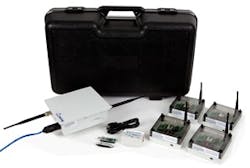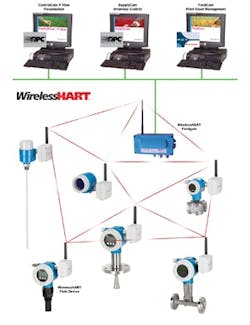From the inception of the HART Communication Protocol, two of the technology's critical capabilities have been interchangeability and interoperability. That is, any HART transmitter must work interchangeably in the same application with any other HART transmitter, regardless of manufacturer, and any HART transmitter must work with all other HART transmitters, again regardless of manufacturer. This has permitted the huge growth of the HART protocol—with now more than 30 million devices installed worldwide. With HART technology, you can have ten transmitters from Vendor X, add three from Vendor Y and expect that they will communicate the same way, operate the same way and use the same handheld communicator or PC program through a HART modem.
Because HART requires interchangeability, you can mix manufacturers and products in the same network. Controllers use the same commands with all devices. Standardized diagnostics are in every device. The same tool works with all manufacturers, and one EDD (Electronic Device Description) works on all EDD-enabled Hosts.
Interchangeability means that you have the freedom to use any revision of the protocol or of the device without mandatory upgrades of tools or applications.
Interoperability Means Standardized Diagnostics.
The HART Protocol has expanded and evolved over the past 20 years. HART 5, the most widely used version of the protocol, was released in 1989. In 2001, the HART Communication Foundation released HART 6, which was adopted by some, but not all, of the manufacturers of HART devices. In 2007, HART 7, which includes WirelessHART, was released, and was immediately adopted by vendors around the world. In 2010, the WirelessHART portion of HART 7 was approved as the first international standard for wireless communication for the process industries (IEC 62591).
HART has always been built upon standards. The IEC recognizes HART as part of its Industrial Communication Networks and Device Description Language (EDDL) standards. WirelessHART is built upon the IEEE 802.15.4 standard for low-power mesh radio networks.
Because of the huge installed base of HART wired transmitters and field devices, it is very well known that HART devices are all interchangeable and interoperable. They all are also backward-compatible. This means that while you can ADD features in subsequent revisions, you cannot remove features or change the meaning of diagnostics or data from a previous revision. This commitment to backward-compatibility and protection of installed assets is what made possible the incredible adaptability of WirelessHART.
There are over 240 vendors who produce HART devices—transmitters, actuators, analyzers, valve positioners and other field devices. Because of the interoperability and interchangeability built into the HART specifications, some of these vendors are building devices on HART 5, some on HART 6, and many are upgrading to HART 7 and WirelessHART. These 240-plus vendors and the owners of the 30 million-plus installed HART devices form a robust ecosystem.
Honeywell Process Solutions has upgraded to HART 7 because of the new features available for wired HART devices. It has chosen to use wired HART because the Experion DCS automatically takes the diagnostics and alternate PV information off the standard 4-20 mADC wiring. Honeywell has produced an adapter to provide older HART transmitters access to its One Wireless plant infrastructure network. "Most of our devices are currently based on HART 6 and will support HART 7, says John Yingst, a Honeywell product manager. "Our Field Device Manager asset management software can currently configure HART 7 devices with additional HART 7 support enhancements planned."
Emerson Process Management was first to market with HART 7 and WirelessHART devices, and now has over a dozen devices including a gateway, network manager software, a WirelessHART adapter (called the THUM because of its shape), several wireless transmitters (pH, flow, temperature, wet chemistry) and smart valve actuators that are wirelessly enabled using WirelessHART.
"We have a complete wireless portfolio," says Bob Karschnia, Emerson's vice president of wireless. "People are solving problems, not just collecting data. THUM adapters make additional data points available that would otherwise remain stranded and provides easy access to information that will enable improved performance. For example, standard Coriolis meters using 4-20mA output often need to be verified to ensure accurate custody transfer and top fiscal performance. A Smart Wireless THUM adapter enables measurement verification in an easy and scheduled way."
ABB's WirelessHART adapter.
ABB has also brought out a new suite of wireless transmitters, including a WirelessHART adapter and a temperature transmitter that can be powered by a power-harvesting device instead of a battery. "While many WirelessHART devices are intended to be battery-powered, we believe that the majority of applications to retrofit existing HART transmitters need no batteries. We have therefore produced a simpler WirelessHART adapter that takes its power directly from the already existing 4-20 mADC loop connection," says ABB CTO Peter Terwiesch.ABB is also proving that the vaunted interoperability and interchangeability of the HART specification extends to WirelessHART. Instead of developing its own gateway, ABB is using one produced by Pepperl+Fuchs.
Gerrit Lohmann, Pepperl+Fuchs' wireless product manager also points out that the extension of HART to wireless also works in the other direction. "I feel that the interest in WirelessHART will also have a positive affect on wired HART multiplexers," he says. "With all of the talk regarding WirelessHART, people are rediscovering the benefits of HART. As the pressure continues to grow to optimize in a cost-effective manner, the stranded HART data contained in legacy instruments will be extracted via the customers' existing hardware, through a HART multiplexer or by the latest WirelessHART solution."
PC WirelessHART gateway
WirelessHART is giving companies that aren't known as field device manufacturers the ability to provide key building blocks of the WirelessHART ecosystem. For example, Pepperl+Fuchs—long known as a networking company, but not as a process transmitter supplier—is supplying gateways both under its own brand and as a private label to other suppliers, as well as a WirelessHART adapter and a temperature converter that converts two temperature sensor values to WirelessHART.Phoenix Contact (PC) is also producing a WirelessHART gateway. Ira Sharp, product marketing lead for wireless for Phoenix Contact, has some thoughts on the security of the WirelessHART network that is connected to his gateway. "WirelessHART uses 128-bit AES encryption for over-the-air communications. This is the same encryption that is used in WPA2, which is the de facto standard for Wi-Fi communications and is accepted by IT professionals around the world," Sharp notes.
"Couple that with a hardened join process for WirelessHART devices requiring every device to have a join key and the ability to change the active advertising features in gateways, and you can limit the accessibility of the network," he points out. "As with any network," he continues, "when looking at network security, there are two things that must be considered. Is the data protected as it flows over the medium (like wireless), and are the devices that are on the network suppose to be there? This relates to encryption and authentication, and WirelessHART covers both of these aspects."
NIVIS is also providing a gateway product, as well as becoming one of the four firmware stack suppliers for WirelessHART. The firmware stack is a chip and code set that takes a standard IEEE 802.15.4 radio and makes it WirelessHART. The fact that there are now four different vendors for the stack indicates how robust the standard is and how interoperability is built into the system from the firmware layer out. NIVIS provides a complete WirelessHART development kit for companies who wish to use its firmware stack.
Siemens, too, has jumped on the HART 7 and WirelessHART bandwagon, with a preliminary offering of pressure and temperature transmitters, a WirelessHART adapter and a WirelessHART gateway. Siemens is also producing a maintenance and diagnostic station to extract and manage maintenance information from wired and WirelessHART field devices.
NIVIS WirelessHART Development Kit.
Endress+Hauser, the world's largest supplier of field transmitters, has produced a WirelessHART adapter and a new version of its Fieldgate protocol gateway to work with WirelessHART. This way, any existing E+H field transmitter can be quickly and easily retrofitted with WirelessHART, and, through the Fieldgate and OPC, communicate with a control system. According to Victor Wolowec, E+H vice president of solutions, "Adding adapters immediately allows any HART 5 device to enter a WirelessHART network and transmit its information to the gateway. This might be process values for monitoring applications or health data which is not normally available over a 4 - 20 mA connection."But it isn't just large companies like Emerson, Siemens, Endress+Hauser, Pepperl+Fuchs and ABB who're bringing out innovative WirelessHART products.
MACTek's Thomas Holmes talks about the MACTek "Bullet," a most interesting implementation of the specification for WirelessHART adapters. "The Bullet WirelessHART adapter is an intelligent communication device that provides cost-effective wireless connectivity to both existing and new control and monitoring applications," he says. "This device is much more than a simple router or converter and should be considered as being more like field-hardened intelligent I/O."
MACTek's product is an example of the diversity of the HART Communication vendor community.
The incredible diversity of the Wireless HART Ecosystem is shown by these adapters.
While there are other WirelessHART adapters, MACTek has taken the adapter concept considerably further than most—and it continues to be entirely interoperable with other devices. Holmes describes the product. "MACTek will offer eight Bullet models differentiated by hazardous-area certification (GP, IS, XP and XP-IS) and by the number of HART field devices supported in HART multidrop mode (two and eight supported devices)," he says. "Every Bullet model supports one device in standard (non-multidrop) HART communication mode or will transmit the measurement PV from a non-HART analog device."ProComSol does HART 7. Its HART modems and PC-based software work fine with HART 7, because it is backward-compatible with all the HART versions before it. "One of the most important new capabilities of HART 7," says Mike Fersky, marketing manager of ProComSol Ltd., "is exception reporting." In exception reporting, the device only reports data if it is significantly different from what went before.
From the largest automation companies to some of the smallest, the depth and breadth of the HART technology ecosystem, wired and wireless, and the HART standards-based solution make the choice of HART communication for any plant an easy one.
Registering a HART device
In 2009, the HART Communication Foundation board of directors voted to require independent testing in order to register a HART device, wired or wireless. This testing is an addition to the testing required of the manufacturer prior to registration testing.
"To verify compliance with the HART Protocol Specification, wired and wireless devices that claim to be "HART Registered" must pass the HART Device Registration Program conducted by the Foundation," says Foundation executive director Ron Helson. "HART registration is available for all process measurement devices, interfaces such as modems, multiplexers and I/O systems, HART masters including systems and handhelds and Device Description (EDD)-enabled host applications."
"100 percent verification tests are conducted to confirm compliance to the HART Protocol standard," says Ed Ladd, HART Communication Foundation director of technology programs. "Running the tests ourselves and independently verifying that submitted devices meet the intent of the standard ensures interoperability—reducing the risk of problems in the field."
But before the Foundation gets the device to test, the manufacturer must do the testing itself—and provide the data to the Foundation, as well as a device for testing. The list of requirements is long, and the procedure is rigorous. "Both good and bad data are sent to see that the device responds appropriately," Ladd says. "For example, test DLL 039 stress test involves two million messages. Devices have to interoperate and be robust on the network," Ladd continues. "To be ‘registered,' a device can miss no more than 20 messages."
Why the detail and rigor? "If you're replacing a device at 2:00 a.m.," Ladd says, "you need to know it's going to communicate—no matter who manufactured it. That's what the registration process is all about."

Leaders relevant to this article:







